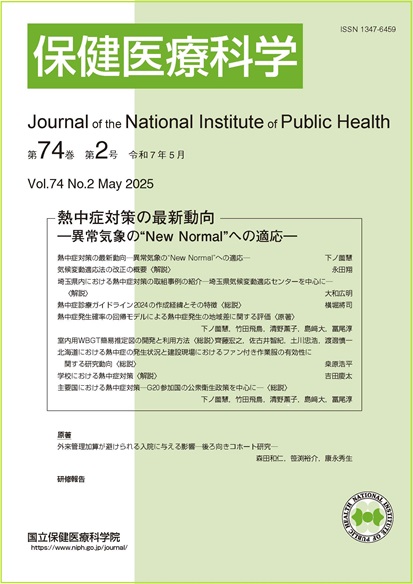Volume 74, Issue 2
State-of-the-art health policy and measures for heatstroke: Adapting to the "New Normal" of Extreme Weather
Displaying 1-18 of 18 articles from this issue
- |<
- <
- 1
- >
- >|
Topics
-
Article type: Preface
2025Volume 74Issue 2 Pages 97
Published: May 30, 2025
Released on J-STAGE: June 10, 2025
Download PDF (1212K) -
Article type: note
2025Volume 74Issue 2 Pages 98-102
Published: May 30, 2025
Released on J-STAGE: June 10, 2025
Download PDF (1572K) Full view HTML -
Article type: note
2025Volume 74Issue 2 Pages 103-111
Published: May 30, 2025
Released on J-STAGE: June 10, 2025
Download PDF (2423K) Full view HTML -
Article type: Review
2025Volume 74Issue 2 Pages 112-118
Published: May 30, 2025
Released on J-STAGE: June 10, 2025
Download PDF (1512K) Full view HTML -
Article type: original
2025Volume 74Issue 2 Pages 119-129
Published: May 30, 2025
Released on J-STAGE: June 10, 2025
Download PDF (2060K) Full view HTML -
Article type: Review
2025Volume 74Issue 2 Pages 130-136
Published: May 30, 2025
Released on J-STAGE: June 10, 2025
Download PDF (1894K) Full view HTML -
Article type: Review
2025Volume 74Issue 2 Pages 137-147
Published: May 30, 2025
Released on J-STAGE: June 10, 2025
Download PDF (1810K) Full view HTML -
Article type: note
2025Volume 74Issue 2 Pages 148-156
Published: May 30, 2025
Released on J-STAGE: June 10, 2025
Download PDF (1652K) Full view HTML -
Article type: Review
2025Volume 74Issue 2 Pages 157-168
Published: May 30, 2025
Released on J-STAGE: June 10, 2025
Download PDF (1349K) Full view HTML
Article
-
Article type: original
2025Volume 74Issue 2 Pages 169-180
Published: May 30, 2025
Released on J-STAGE: June 10, 2025
Download PDF (1447K) Full view HTML
Educational Reports
-
Article type: Educational Report
2025Volume 74Issue 2 Pages 181-183
Published: May 30, 2025
Released on J-STAGE: June 10, 2025
Download PDF (1361K) Full view HTML -
Article type: Educational Report
2025Volume 74Issue 2 Pages 184-186
Published: May 30, 2025
Released on J-STAGE: June 10, 2025
Download PDF (1280K) Full view HTML -
Article type: Educational Report
2025Volume 74Issue 2 Pages 187-188
Published: May 30, 2025
Released on J-STAGE: June 10, 2025
Download PDF (1244K) Full view HTML -
Article type: Educational Report
2025Volume 74Issue 2 Pages 189-190
Published: May 30, 2025
Released on J-STAGE: June 10, 2025
Download PDF (1242K) Full view HTML -
Article type: Educational Report
2025Volume 74Issue 2 Pages 191-192
Published: May 30, 2025
Released on J-STAGE: June 10, 2025
Download PDF (1384K) Full view HTML -
Article type: Educational Report
2025Volume 74Issue 2 Pages 193-194
Published: May 30, 2025
Released on J-STAGE: June 10, 2025
Download PDF (1241K) Full view HTML -
Article type: Educational Report
2025Volume 74Issue 2 Pages 195-196
Published: May 30, 2025
Released on J-STAGE: June 10, 2025
Download PDF (1351K) Full view HTML -
Article type: Educational Report
2025Volume 74Issue 2 Pages 197-198
Published: May 30, 2025
Released on J-STAGE: June 10, 2025
Download PDF (1311K) Full view HTML
- |<
- <
- 1
- >
- >|
